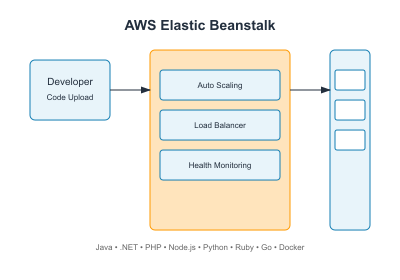AWS Elastic Beanstalk: A Developer's Streamlined Deployment
 Gedion Daniel
Gedion Daniel
AWS Elastic Beanstalk provides developers with a managed service for deploying and scaling web applications. This platform significantly simplifies the deployment process while maintaining developer control over the underlying infrastructure.
Core Developer Benefits
Simplified Application Deployment
Elastic Beanstalk transforms application deployment into a streamlined process. Developers need only upload their application code, and the service automatically handles deployment complexities. The platform manages capacity provisioning, load balancing, auto-scaling, and application health monitoring, allowing developers to focus on writing code rather than managing infrastructure.
Platform Flexibility
The service supports multiple programming languages and frameworks, including:
Java (with Tomcat) .NET (with Windows Server) PHP Node.js Python Ruby Go Docker
This versatility enables developers to use their preferred development tools and maintain existing coding practices without adaptation to proprietary platforms.
Development Environment Integration
Elastic Beanstalk seamlessly integrates with popular development tools. Developers can deploy applications directly from integrated development environments (IDEs) through plugins for Eclipse and Visual Studio. The service also supports deployment through the AWS Management Console, Command Line Interface (CLI), or APIs, providing flexibility in development workflows.
Version Management Capabilities
The platform maintains versions of deployed applications, enabling developers to:
Track deployment history Roll back to previous versions instantly Deploy multiple versions for testing Maintain separate development, staging, and production environments
Operational Advantages
Infrastructure Management
Elastic Beanstalk automates infrastructure management tasks including:
Server provisioning Database integration Load balancer configuration Auto-scaling setup Security updates Monitoring implementation
This automation reduces operational overhead and minimizes configuration errors.
Cost Optimization
Developers benefit from cost-effective deployment as Elastic Beanstalk:
Charges no additional fees beyond the AWS resources used Automatically scales resources based on demand Enables environment cloning for testing without duplicate resource costs Provides resource optimization recommendations
Monitoring and Management
The service offers comprehensive monitoring capabilities through:
Integration with Amazon CloudWatch Built-in health monitoring dashboard Log file access and management Performance metrics tracking Custom metric creation options
Security and Compliance
Security Features
Elastic Beanstalk provides robust security through:
Integration with AWS Identity and Access Management (IAM) VPC integration for network isolation SSL/TLS certificate management Security group configuration Regular platform updates and patches
Compliance Support
The platform helps maintain compliance requirements by:
Supporting industry standards and certifications Providing audit logs Enabling encryption at rest and in transit Facilitating regular security assessments
Development Workflow Enhancement
Local Development
Developers can maximize productivity through:
Local testing with Docker containers Environment parity between development and production Configuration file version control Command-line interface for local testing
Continuous Integration/Continuous Deployment (CI/CD)
Elastic Beanstalk enhances CI/CD practices by:
Supporting automated deployments Integrating with AWS CodePipeline Enabling blue-green deployments Facilitating automated testing
Best Practices
Configuration Management
For optimal development efficiency:
Use configuration files (.ebextensions) Implement environment variables appropriately Maintain separate configurations for different environments Document custom configurations
Resource Organization
Organize resources effectively by:
Using meaningful application and environment names Implementing proper tagging strategies Creating environment groups for related applications Maintaining clear version labeling
Deployment Strategies
Optimize deployments through:
Implementation of rolling updates Use of immutable deployments for critical applications Regular testing of deployment procedures Maintenance of deployment documentation
Conclusion
AWS Elastic Beanstalk significantly enhances developer productivity by automating infrastructure management while maintaining flexibility and control. The platform's integration capabilities, comprehensive monitoring, and security features make it an ideal choice for teams seeking to streamline their application deployment process.
For detailed implementation guidance, developers should consult the AWS Elastic Beanstalk Developer Guide and explore AWS's extensive documentation and resources. The service continues to evolve, regularly adding new features and capabilities to support modern application development needs.
Subscribe to my newsletter
Read articles from Gedion Daniel directly inside your inbox. Subscribe to the newsletter, and don't miss out.
Written by

Gedion Daniel
Gedion Daniel
I am a Software Developer from Italy.